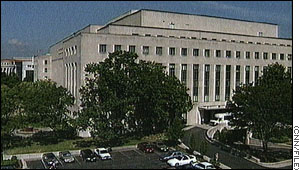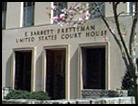|
|
|
Prettyman.Freeservers.Com |
 |
| E. Barrett Prettyman Courthouse |
By Toni Locy
Washington Post Staff Writer
Thursday, March 27, 1997; Page J01
Article about the dedication of the E Barrett Prettyman Courthouse.
Submitted by Charles Prettyman
After nearly 45 years in virtual anonymity, the courthouse that was the scene of historic arguments on the Pentagon Papers, the Watergate trials and the first appearance by a first lady before a federal grand jury now has a name. The U.S. Courthouse has become the E. Barrett Prettyman Courthouse. Prettyman died in 1971, and not many people remember him. But, just like the building named after him, Prettyman has a place in history. Appointed by President Harry S. Truman, he served on the prestigious U.S. Court of Appeals for the D.C. Circuit for 26 years, including two years as chief judge. He taught tax law at Georgetown University. He was general counsel to the old Internal Revenue Bureau. He was corporation counsel for the District in the mid-1930s. And he was chosen to determine whether Francis Gary Powers handled himself appropriately after his U-2 spy plane was downed over the Soviet Union in 1962.
During a dedication ceremony last week, Prettyman's accomplishments were ticked off to explain why the nondescript gray building at Third Street and Constitution Avenue NW will carry his name. His achievements were extolled by some respected judges, including William H. Rehnquist, the chief justice of the United States. Prettyman's credentials were impressive, but the case for naming a building after him was helped by one of his former law clerks -- John W. Warner, now the senior U.S. senator from Virginia -- who pushed the christening legislation through Congress. U.S. District Judge Louis F. Oberdorfer, the courthouse's resident historian, regaled spectators with stories from Prettyman's papers, which he found at the Library of Congress.
Prettyman kept two diaries, one when he was in the Army in which he anguished over learning to kill with a bayonet. In the other, he wrote about being pressured to make politically motivated tax rulings while he was counsel to the Internal Revenue Bureau in the early days of the New Deal. "It [reads] like Tom Sawyer," Oberdorfer said. Born in 1891 in Lexington, Va., the courtly but passionate southerner witnessed exciting times and much change. Oberdorfer said Prettyman wrote about growing up as a Methodist minister's son, seeing his first movie, "The Great Train Robbery," and driving on a dirt road from Rockville to Washington.
As a young lawyer, he hung out his shingle in 1916 in Hopewell, Va., so raucous a town that Prettyman carried a pistol. He worked as a newspaperman on the side, running at least two papers. A few years earlier, as manager of the Randolph-Macon College football team, he boldly enlisted the help of President William H. Taft to persuade the school's faculty to lift its ban on students' attending the last game of the year.
It seems that Prettyman, the team manager, was to blame for the punishment because he liberally interpreted a half-day leave for the team to travel to the previous game and the team took the whole day off. The faculty was incensed and banned students from attending the season finale. When Prettyman heard that Taft was going to be in Richmond, he went to the governor's mansion, and somehow, cornered the president. Oberdorfer said Taft roared with laughter, telling the young man he didn't think he could help. But the next day, Taft's train made a brief stop near the school. "About this football situation," Taft began, according to Oberdorfer. Taft told the "boys" that if they were "locked up in a federal penitentiary," he could help them. Unfortunately, they were in college and not under his control. But the faculty got the message and relented, allowing the students to attend the football game.
Eventually, Prettyman put away childish things -- and his gun -- and moved to Washington, where he became active in politics and social programs, and made a name for himself as a tax lawyer. In 1945, he went on the bench. Asked what his father might say about the Prettyman courthouse, E. Barrett Prettyman Jr. said: "Are you kidding? He'd love it. He loved that courthouse." Prettyman said his father jockeyed for years to get chambers with a view of Pennsylvania Avenue, where any parade worth watching passes by. "The whole family would go," Prettyman Jr. recalled. "It was great fun." Warner remembered Prettyman's excitement as he watched workers erect the triangular 24-foot-high shaft of granite in front of the building. It was Prettyman's brainchild, with excerpts of the Declaration of Independence, the Constitution and the Fifth Amendment on one side and scenes depicting portions of the Bill of Rights on the others. Barrett Prettyman Jr. said his father was sensitive to individual rights, especially unlawful searches of homes, mainly because he never had a real home of his own until he was an adult. The family lived a nomadic life because the Rev. Forrest J. Prettyman moved from parsonage to parsonage. During his years on the court, Prettyman often was the "swing man," the pivotal vote on key cases, Oberdorfer said. He stood "shoulder to shoulder" with Judge David L. Bazelon in the landmark Durham case, which broadened the insanity defense. He was one of the leaders in establishing the city's first legal aid society. And he was the father of court administrative procedures.
But he was "no bleeding heart," Oberdorfer said. Prettyman, in a speech, called drug dealers "the slimiest reptiles in the human race," driven by money to "the destruction of all that is good and decent in people." Warner recalled how important good and decent people were to Prettyman and how the judge worried about a particular case in which developers and government officials wanted to take land in Southwest Washington by condemning it and forcing many people to leave their homes. One day, Warner said, Prettyman burst into his office and told his young law clerk to get his coat. They headed for Southwest Washington, stopping every time Prettyman saw a neatly kept home amid the bleakness. In the end, the judge sided with the developers, telling Warner: "I will go to my grave remembering those houses. But we must have progress." Articles appear as they were originally printed in The Washington Post and may not include subsequent corrections.
The following is an excerpt from the District of Columbia Circuit Court Website
E. BARRETT PRETTYMAN UNITED STATES COURTHOUSE
333 Constitution Ave. NW, Washington DC 20001

The Historical Society of the District of Columbia Circuit
The History of the Courts of the D.C. Circuit
The Act to Designate the United States Courthouse in Washington, District of Columbia, as the "E. Barrett Prettyman United States States Courthouse"
Location Map from the District of Columbia Circuit Court Website
Visit the District of Columbia Circuit Court website
E. Barrett Prettyman From Wikipedia, the free encyclopedia
Thank you for visiting Prettyman.Freeservers.Com
This page revised: October 2, 2000, November 2010
You are visitor # 



